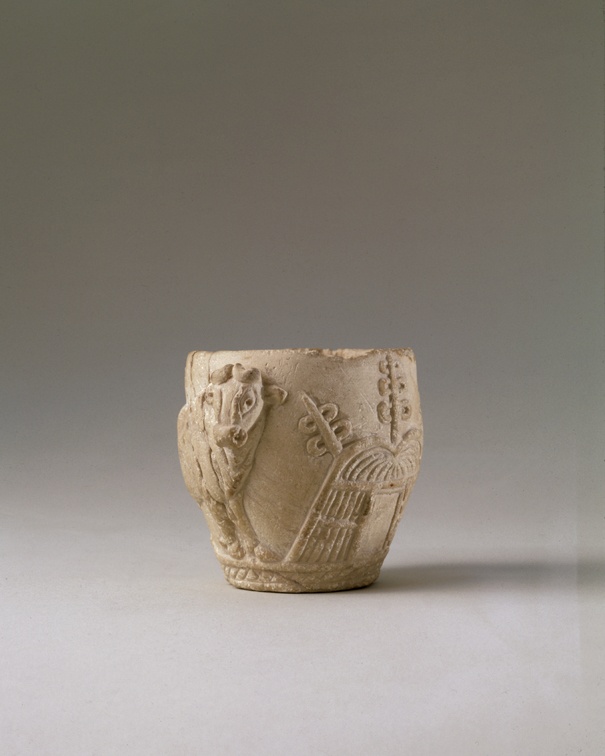
Limestone
H: 6.2 cm. Diam: 6 cm
Allegedly from Ur
Proto-Sumerian
Djemdet Nasr period. c. 3000 B.C.
Condition: complete but with several cracks and three small pieces glued back in place on the chipped rim, and a hole behind the reclining heifer. A few stains on the surface.
A vessel decorated with a standing bull in low relief, his turned head in high relief; also in low relief a reclining young heifer and a sacred stable surmounted by emblematic poles [1]. The stable built of reeds with reinforced tubular uprights and horizontals. An Early Sumerian bowl in stone from Khafaje has a similar type of representation [2].
These form part of the same iconographic group as a magnificent gypsum trough from Warka decorated in low relief with a sacred stable and sheep, probably used for the temple flock [3]; their purpose is ritual, to invoke divine providence for the herd or to manifest gratitude to the god for past bounty [4] possibly dedicated to the god of vegetation Dumuzi, the "Real Son" legendary king of Uruk, called the Shepherd, who is later known as Tammuz [5].
1 A parallel for the stable and poles is a fragment of a large ritual alabaster vase of the Djemdet Nasr period in Paris, Louvre Museum AO 8842: Amiet, P.: L'Art Antique du Proche-Orient (Paris, 1977), no. 231, pp. 354, 442; for greater resemblance, see a cylinder seal in limestone from Khafaje, likewise of the Djemdet Nasr period, in the Baghdad Museum: Orthmann, W.: Der Alte Orient, PKG 14 (Berlin, 1975), no. 127b, p. 226 - here the surrounding herds are ascribed to Tammuz (?).
2 Baghdad, Iraq Museum: Orthmann, W.: op. cit., p. 183 pl. 71b.
3 London, British Museum WA 120 000: Frankfort, H.: The Art and Architecture of the Ancient Orient (Harmondsworth, 1970), p. 27 fig. 12.
4 Porada, E.: Problems of Style and Iconography in Early Sculptures of Mesopotamia and Iran, in: In Memoriam Otto J. Brendel (Mainz, 1976), p. 4.
5 Amiet, P.: op. cit., p. 566.